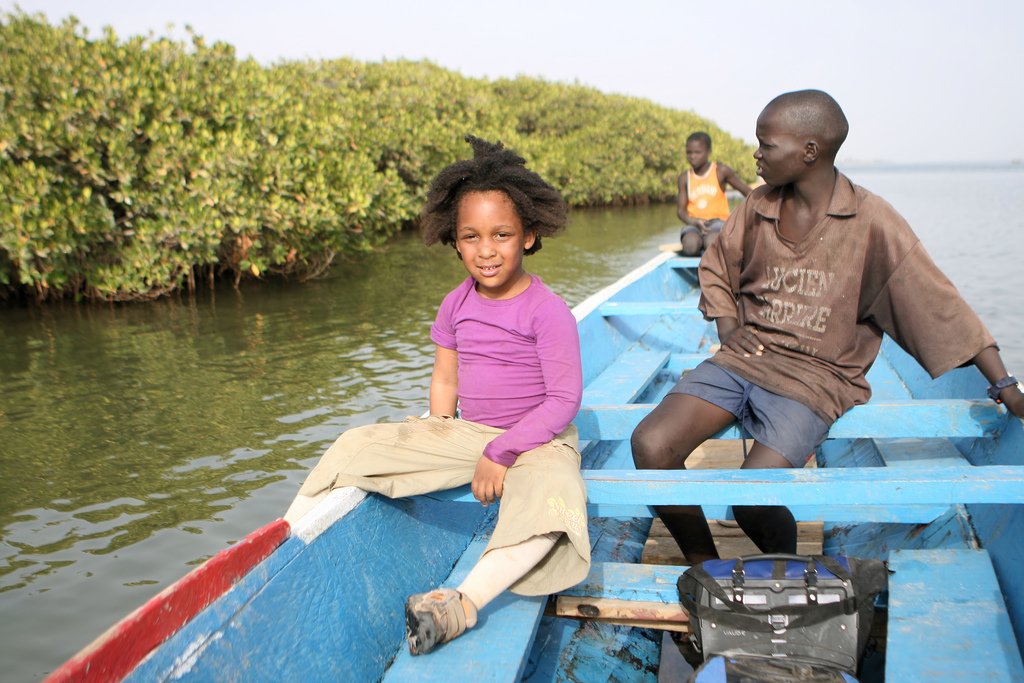
Africa’s shoreline is threatened by sea level rise, as coastal cities expand rapidly. Jean-Marc Liotier.
Mangroves that could protect Cameroon from rising seas may be subject to more pressure than they can bear, as people migrating to the country’s southwestern coast clear trees at a rate so fast they can’t regenerate, scientists at the Center for International Forestry Research (CIFOR) said.
As the world grapples with the affects of climate change, it cannot afford to ignore these unique, watery worlds, said Bele Mekou Youssoufa, co-author of Vulnerability to coastal flooding and response strategies: the case of Cameroon mangrove forests.
“Even if we negate all benefits of mangroves as forests, their value as the ‘shore-line protector’ should be enough to convince us to conserve them,” he said, noting the trees’ roots spread across a large area, soaking up water and encouraging sedimentation.
That not only helps stabilise tidal and freshwater inputs, according to recent CIFOR research, but helps prevent soil erosion.
“They are our saviours — playing a role beyond what could ever be performed though engineering or technological solutions,” Youssoufa said
According to UN Water, a third of the world’s population of 7 billion live within a hundred kilometers of the ocean, leaving many of them subject to coastal flooding every year. The burden is especially severe in developing countries and small island mega-deltas, says the Intergovernmental Panel on Climate Change.
This issue will be one of the topics of discussion at the two-day conference Sustainable forest management in Central Africa: Yesterday, today and tomorrow Yaounde, Cameroon. 22-23 May, 2013.
For CIFOR’s special feature on Central Africa’s forests, visit forestsnews.cifor.org/yaounde
The situation in Cameroon has been exacerbated by a population shift.
At least 30 percent of the people live in such coastal towns as Douala, Limbe, Tiko and Kribi — three-quarters of them on strips on land a thousand metres or less from the shoreline and many just a meter above sea-level, according to the research paper.
“In the process,” Youssouf warned, “they’re clearing forest at a faster rate than is sustainable for regeneration.”
Not just the environment, but livelihoods at risk
Cameroon’s coastal mangrove zone stretches 400 kilometers from the Equatorial border of Guinea to Nigeria.
When the Atlantic Ocean tide is low, the forest extends inland for about 30 kilometres, but there has been a progressive loss of about 1,000 hectares of tree cover in the country over 43 years — seriously impacting resources and biodiversity.
That, in turn, affects livelihood opportunities.
Mangroves are sources of such highly-valued commercial products as fuel wood and — as key spawning grounds — fish. They are also sites for a burgeoning eco-tourism industry, vital to local and national development.
“Those who depend on mangroves are going to become increasingly vulnerable,” Youssoufa said.

Mangrove deforestation related to flooding, Cameroon. Munji et al.
As the world warms, resulting in sea level rises, “flood occurrence is expected to quadruple by 2080,” he said, creating a problem which will contribute to the degradation of whatever mangroves remain.
That’s likely to worsen shoreline erosion, prompt migration of mangrove forests inland or seaward, endanger other plant and animal species, and allow salt water to intrude groundwater and estuaries.
Shifting some of the focus to mangrove forests
In Africa, as with many parts of the world, efforts to adapt to and mitigate the effects of climate change have focused largely on slowing deforestation and degradation in plush tropical, inland forests (REDD+).
But Youssoufa and his co-author, CIFOR scientist Denis Sonwa, believe more attention should be paid to wetter parts and water forests.
“Mangroves are still forests, and deserve some management plan and better regulation as other forests do,” Sonwa said.
“Efforts to establish the extent of vulnerability of specific human and ecological systems on the ground and to investigate interactions between climate-influenced factors and human and ecological systems are regrettably limited.”
Poverty and a lack of information, supervision and law enforcement may be some of the biggest obstacles to protecting mangroves in the country’s extreme southwest.
“Importantly, the essential role mangroves play needs to be regularly explained to the population and stakeholders such as decision makers,” said Sonwa, adding for example, that people now take advantage of the floods in Cameroon to access mangroves as an alternative fuel source.
“We need to see mangroves as part of the solution to mitigate and adapt to climate change.”
Youssoufa agreed.
In addition to the role they play now, he believes mangroves could hold the genetic key to engineering salt-tolerant crops amid global warming.
“That,” he said, “could be a future resource for when most of our coastal areas become flooded.”
For more information about the issues discussed in this article, please contact Bele Youssoufa at b.youssoufa@cgiar.org
This work forms part of the Congo Basin Forest and Climate Change Adaptation (CoFCCA) project and the CGIAR Research Program on Forests, Trees and Agroforestry. It was supported by the Canadian International Development Research Center (IDRC), the UK Department for International Development (DFID) and the European Union.
We want you to share Forests News content, which is licensed under Creative Commons Attribution-NonCommercial-ShareAlike 4.0 International (CC BY-NC-SA 4.0). This means you are free to redistribute our material for non-commercial purposes. All we ask is that you give Forests News appropriate credit and link to the original Forests News content, indicate if changes were made, and distribute your contributions under the same Creative Commons license. You must notify Forests News if you repost, reprint or reuse our materials by contacting forestsnews@cifor-icraf.org.




